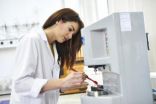(Press-News.org) Amsterdam, NL, 10 July 2014 – Up to 70% of Parkinson's disease (PD) patients experience sleep problems that negatively impact their quality of life. Some patients have disturbed sleep/wake patterns such as difficulty falling asleep or staying asleep, while other patients may be subject to sudden and involuntary daytime sleep "attacks." In the extreme, PD patients may exhibit REM-sleep behavior disorder (RBD), characterized by vivid, violent dreams or dream re-enactment, even before motor symptoms appear. A review in the Journal of Parkinson's Disease discusses the underlying causes of sleep problems in PD, as well as medications, disease pathology, and comorbidities, and describes the most appropriate diagnostic tools and treatment options.
Sleep problems in PD patients can have wide-ranging adverse effects and can worsen in later stages of the disease. Sleepiness socially isolates patients and excessive sleepiness can put patients at risk of falls or injury, and can mean patients must give up driving. Sleepiness can impair cognition and concentration, exacerbate depression, and interfere with employment. Wakefulness at night impairs daytime wakefulness and may also cause mood instabilities and can exhaust caregivers.
"Diagnosis and effective treatment and management of these problems are essential for improving the quality of life and reducing institutionalization of these patients," says lead author Wiebke Schrempf, MD, Technische Universität Dresden, Faculty of Medicine Carl Gustav Carus, Department of Neurology, Division of Neurodegenerative Diseases, Dresden, Germany.
Dr. Schrempf and colleagues describe some of the complexities associated with treating sleep problems in PD patients, such as the worsening of sleep problems by dopaminergic medications used to treat motor symptoms. Lower doses of levodopa or dopamine agonists are able to improve sleep quality partly by reducing motor symptoms such as nighttime hypokinesia (decreased body movement), dyskinesia (abnormal voluntary movements), or tremor (involuntary shaking), which interfere with normal sleep. However, the same medications may also cause excessive daytime sleepiness. The report describes how changing medication, dose, duration of treatment, or timing of administration can improve outcomes.
The presence of other conditions common in PD patients such as depression, dementia, hallucinations, and psychosis may interfere with sleep. Unfortunately, some antidepressants can also impair sleep.
Sleep problems may also be harbingers of future neurodegenerative disease. Patients with RBD exhibit intermittent loss of normal muscle relaxation during REM sleep and engage in dream enactment behavior during which they may shout, laugh, or exhibit movements like kicking and boxing. "RBD seems to be a good clinical predictor of emerging neurodegenerative diseases with a high specificity and low sensitivity, whereas other early clinical features of PD, such as olfactory dysfunction and constipation, are less specific," says Dr. Schrempf. "These early clues may help identify PD patients before motor symptoms appear, when disease-modifying therapies may be most beneficial."
PD is the second most common neurodegenerative disorder in the United States, affecting approximately one million Americans and five million people worldwide. Its prevalence is projected to double by 2030. The most characteristic symptoms are movement-related, such as involuntary shaking and muscle stiffness. Non-motor symptoms, such as worsening depression, cognition, and anxiety, olfactory dysfunction, and sleep disturbances, can appear prior to the onset of motor symptoms.
INFORMATION: END
Sleep disturbances, common in Parkinson's disease, can be early indicator of disease onset
Problems run the gamut from excessive wakefulness to excessive sleepiness, according to new review in the Journal of Parkinson's Disease
2014-07-10
ELSE PRESS RELEASES FROM THIS DATE:
Rice's silicon oxide memories catch manufacturers' eye
2014-07-10
Rice University's breakthrough silicon oxide technology for high-density, next-generation computer memory is one step closer to mass production, thanks to a refinement that will allow manufacturers to fabricate devices at room temperature with conventional production methods.
First discovered five years ago, Rice's silicon oxide memories are a type of two-terminal, "resistive random-access memory" (RRAM) technology. In a new paper available online in the American Chemical Society journal Nano Letters, a Rice team led by chemist James Tour compared its RRAM technology ...
Mayo Clinic calls for standardization of safe imaging protocols for children
2014-07-10
ROCHESTER, Minn. — The benefits of medical imaging far outweigh the risks when children receive The Right Exam, ordered The Right Way, with The Right Radiation Dose. However, overuse and misuse of imaging change the benefit-risk ratio and Mayo Clinic is leading a collaborative effort to ensure a national protocol is put into action. The commentary, published online in the Journal of Patient Safety, calls for the American College of Radiology, the Joint Commission, the Intersociety Accreditation Commission, and the Centers for Medicare & Medicaid Services to require three ...
NOAA's GOES-West satellite sees smoke from Canadian fires over US
2014-07-10
NOAA's Geostationary Operational Environmental Satellite or GOES-West satellite spotted smoke over the U.S. Mid-West from dozens of fires raging in Canada's Northwestern Territories.
At 1200 UTC (8 a.m. EDT) on July 9, 2014, GOES-West captured this image of the brownish-colored haze created by forest fires in Canada's Northwest Territories that drifted all the way into South Dakota. This image was created by the NASA GOES Project at NASA Goddard Space Flight Center, Greenbelt, Md.
According to Canada's Natural Resources, Canadian Wildland Fire Information System, fire ...
NASA sees Tropical Storm Neoguri losing punch along southern Japan's coast
2014-07-10
Once a powerful super typhoon, now an weakening tropical storm, NASA's Terra satellite saw a much weaker Tropical Storm Neoguri moving along the southern coast of Japan.
On July 10 at 0:35 UTC, the Moderate Resolution Imaging Spectroradometer (MODIS) instrument aboard NASA's Terra satellite captured an image of a more disorganized Tropical Storm Neoguri over east central Japan. At the time of the image, a more elongated Tropical Storm Neoguri's center was east of Kyushu, Japan.
A visible image from the Visible Infrared Imaging Radiometer Suite (VIIRS) instrument aboard ...
Sun-like stars reveal their ages
2014-07-10
Defining what makes a star "Sun-like" is as difficult as defining what makes a planet "Earth-like." A solar twin should have a temperature, mass, and spectral type similar to our Sun. We also would expect it to be about 4.5 billion years old. However, it is notoriously difficult to measure a star's age so astronomers usually ignore age when deciding if a star counts as "Sun-like."
A new technique for measuring the age of a star using its spin - gyrochronology - is coming into its own. Today astronomers are presenting the gyrochronological ages of 22 Sun-like stars. Before ...
World interest in research work on the benefits of the Okra plant
2014-07-10
Estonian-born Katerina Alba's research at the University of Huddersfield could help to improve the quality of some of the most popular emulsion-based food products – such as butter, mayonnaise, yoghurt and fruit drinks – and she is starting to gain an international profile for her work.
Katerina gained her MSc degree in nutrition and food science at the University and now she has embarked on research for a PhD. Working with her supervisor, Dr Vassilis Kontogiorgos, she is investigating the potential of carbohydrates extracted from the pods of the okra plant. They can ...
Understanding consciousness
2014-07-10
EVANSTON, Ill. --- Why does a relentless stream of subjective experiences normally fill your mind? Maybe that's just one of those mysteries that will always elude us.
Yet, research from Northwestern University suggests that consciousness lies well within the realm of scientific inquiry -- as impossible as that may currently seem. Although scientists have yet to agree on an objective measure to index consciousness, progress has been made with this agenda in several labs around the world.
"The debate about the neural basis of consciousness rages because there is no widely ...
Bacterial colonization prior to catching the flu may protect against severe illness
2014-07-10
Many studies have shown that more severe illness and even death are likely to result if you develop a secondary respiratory infection after developing influenza. Now, however, a team of researchers based at The Wistar Institute has determined that if you reverse the order of infection, the bacteria Streptococcus pneumoniae (often called pneumococcus) may actually protect against a bad case of the flu.
The researchers discovered that the bacterial protein pneumolysin, which is described as a bacterial virulence factor, might protect macrophages—a type of immune system ...
What's a concussion? Review identifies four evidence-based indicators
2014-07-10
(July 10, 2014) – A research review identifying the clinical indicators most strongly associated with concussion is an important first step in the process of developing evidence-based guidelines for concussion diagnosis, prognosis, and treatment, according to a new report published by Neurosurgery, official journal of the Congress of Neurological Surgeons. The journal is published by Lippincott Williams & Wilkins, a part of Wolters Kluwer Health.
Based on analysis of the best available research data, a multidisciplinary panel of experts has identified a set of four ...
For children with pacemakers, 'self-competence' affects quality of life
2014-07-10
July 10,2014 – For children and teens living with a cardiac pacemaker, a low sense of self-competence seems to contribute to decreased quality of life, reports a study in the July Journal of Developmental & Behavioral Pediatrics, the official journal of the Society for Developmental and Behavioral Pediatrics. The journal is published by Lippincott Williams & Wilkins, a part of Wolters Kluwer Health.
"Self-competence may function as a protective factor against lower health-related quality of life in children with pacemakers," according to the study by Ana M. Gutierrez-Colina ...
LAST 30 PRESS RELEASES:
Tracing the quick synthesis of an industrially important catalyst
New software sheds light on cancer’s hidden genetic networks
UT Health San Antonio awarded $3 million in CPRIT grants to bolster cancer research and prevention efforts in South Texas
Third symposium spotlights global challenge of new contaminants in China’s fight against pollution
From straw to soil harmony: International team reveals how biochar supercharges carbon-smart farming
Myeloma: How AI is redrawing the map of cancer care
Manhattan E. Charurat, Ph.D., MHS invested as the Homer and Martha Gudelsky Distinguished Professor in Medicine at the University of Maryland School of Medicine
Insilico Medicine’s Pharma.AI Q4 Winter Launch Recap: Revolutionizing drug discovery with cutting-edge AI innovations, accelerating the path to pharmaceutical superintelligence
Nanoplastics have diet-dependent impacts on digestive system health
Brain neuron death occurs throughout life and increases with age, a natural human protein drug may halt neuron death in Alzheimer’s disease
SPIE and CLP announce the recipients of the 2025 Advanced Photonics Young Innovator Award
Lessons from the Caldor Fire’s Christmas Valley ‘Miracle’
Ant societies rose by trading individual protection for collective power
Research reveals how ancient viral DNA shapes early embryonic development
A molecular gatekeeper that controls protein synthesis
New ‘cloaking device’ concept to shield sensitive tech from magnetic fields
Researchers show impact of mountain building and climate change on alpine biodiversity
Study models the transition from Neanderthals to modern humans in Europe
University of Phoenix College of Doctoral Studies releases white paper on AI-driven skilling to reduce burnout and restore worker autonomy
AIs fail at the game of visual “telephone”
The levers for a sustainable food system
Potential changes in US homelessness by ending federal support for housing first programs
Vulnerability of large language models to prompt injection when providing medical advice
Researchers develop new system for high-energy-density, long-life, multi-electron transfer bromine-based flow batteries
Ending federal support for housing first programs could increase U.S. homelessness by 5% in one year, new JAMA study finds
New research uncovers molecular ‘safety switch’ shielding cancers from immune attack
Bacteria resisting viral infection can still sink carbon to ocean floor
Younger biological age may increase depression risk in older women during COVID-19
Bharat Innovates 2026 National Basecamp Showcases India’s Most Promising Deep-Tech Ventures
Here’s what determines whether your income level rises or falls
[Press-News.org] Sleep disturbances, common in Parkinson's disease, can be early indicator of disease onsetProblems run the gamut from excessive wakefulness to excessive sleepiness, according to new review in the Journal of Parkinson's Disease



